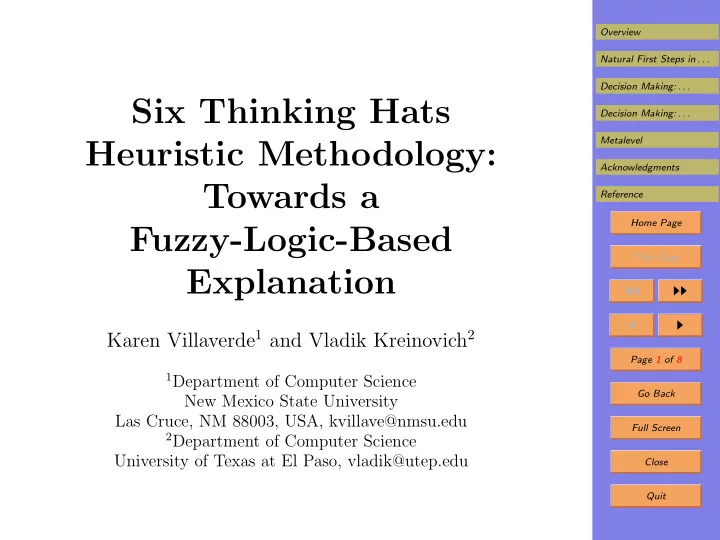

Overview Natural First Steps in . . . Decision Making: . . . Six Thinking Hats Decision Making: . . . Metalevel Heuristic Methodology: Acknowledgments Towards a Reference Home Page Fuzzy-Logic-Based Title Page Explanation ◭◭ ◮◮ ◭ ◮ Karen Villaverde 1 and Vladik Kreinovich 2 Page 1 of 8 1 Department of Computer Science Go Back New Mexico State University Las Cruce, NM 88003, USA, kvillave@nmsu.edu Full Screen 2 Department of Computer Science University of Texas at El Paso, vladik@utep.edu Close Quit
Overview 1. Overview Natural First Steps in . . . • How do we enhance reasoning and decision making? Decision Making: . . . Decision Making: . . . • In his widely used Six Thinking Hats book, Eduardo Metalevel de Bono proposed a heuristic for this. Acknowledgments • This heuristic is based on separating different reasoning Reference modes (“hats”). Home Page • In this talk, we show that his heuristics can be (at least Title Page partly) explained in terms of fuzzy logic. ◭◭ ◮◮ • Fuzzy logic is a technique in which we explicitly asso- ◭ ◮ ciate a degree of confidence: Page 2 of 8 – with each fact and, – more generally, each statement from our knowledge Go Back base. Full Screen • The degree of confidence is, usually, a number from the Close interval [0,1]. Quit
Overview 2. Natural First Steps in Decision Making Natural First Steps in . . . • Ideally, it is desirable to come up with a solution which Decision Making: . . . about which we are absolutely sure. Decision Making: . . . Metalevel • For that, we can only use facts and statements about Acknowledgments which we are absolutely confident. Reference • This correspond to white hat . Home Page • Often, such absolutely confident knowledge is not suf- Title Page ficient. ◭◭ ◮◮ • In such situations, we need to also take into account ◭ ◮ knowledge in which we are less confident. Page 3 of 8 • This corresponds to red hat . Go Back • In the red hat reasoning, we can use known solutions s to similar problems. Full Screen • Namely, we assume that the desired solution to the Close actual problem be close to s . Quit
Overview 3. Decision Making: Next Steps Natural First Steps in . . . • Sometimes, the red hat reasoning leads to success. Decision Making: . . . Decision Making: . . . • In other cases, when using statements in which we have Metalevel less confidence, we get confused. Acknowledgments • Indeed, for a proposal, we may have both arguments Reference for and against the proposal to be a good solution. Home Page • This confusion comes from the fact that in logic, we Title Page usually try to combine all the facts and statements. ◭◭ ◮◮ • In case of confusion, it may make sense to separate ◭ ◮ them: Page 4 of 8 – separately consider statements and facts which are “for”, and Go Back – separately consider ones which are “against”. Full Screen • After this, we reconcile the results. Close • This corresponds to yellow and black hats. Quit
Overview 4. Decision Making: Final Step Natural First Steps in . . . • Sometimes, the separation into “for” and “against” ar- Decision Making: . . . guments works well. Decision Making: . . . Metalevel • In other cases, it still does not work. In such cases: Acknowledgments – instead of looking for solutions which are close to Reference the known solution s of a similar problem, Home Page – we can try to looks for solutions which are explicitly Title Page required to be different from s . ◭◭ ◮◮ • This can be done in different ways: ◭ ◮ – we can explicitly add a requirement that the solu- Page 5 of 8 tion is different from s , or – we can randomly perturb s into s ′ and require that Go Back the actual solution is close to the s ′ . Full Screen • This corresponds to the green hat. Close Quit
Overview 5. Metalevel Natural First Steps in . . . • So far, we have described individual strategies (“hats”). Decision Making: . . . Decision Making: . . . • To successfully solve the problem, we need to switch Metalevel from one “hat” to another. Acknowledgments • Thus, to successfully solve the problem, we need to Reference decide: Home Page – when we give up on one “hat” and move to the next Title Page one, and/or ◭◭ ◮◮ – when we go back to the original “hat”. ◭ ◮ • The corresponding meta-strategy is what is called blue Page 6 of 8 hat. Go Back Full Screen Close Quit
Overview 6. Acknowledgments Natural First Steps in . . . This work was supported in part by: Decision Making: . . . Decision Making: . . . • the National Science Foundation grant HRD-0734825 Metalevel (Cyber-ShARE Center of Excellence); Acknowledgments • the National Science Foundation grant DUE-0926721; Reference • Grant 1 T36 GM078000-01 from the National Insti- Home Page tutes of Health; and Title Page • a grant on F-transforms (fuzzy transforms) from the ◭◭ ◮◮ Office of Naval Research. ◭ ◮ Page 7 of 8 Go Back Full Screen Close Quit
7. Reference Overview Natural First Steps in . . . Eduardo de Bono, Six Thinking Hats , MICA Management Decision Making: . . . Decision Making: . . . Resources, New York, 1999. Metalevel Acknowledgments Reference Home Page Title Page ◭◭ ◮◮ ◭ ◮ Page 8 of 8 Go Back Full Screen Close Quit
Recommend
More recommend